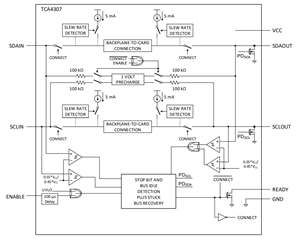Hi,
I'd like to use something like the TCA4307 to support hot swap on an i2c bus.
I notice in the datasheet that it is most normal to place this device on the removable peripheral card, however I would prefer to avoid that for space and simplicity reasons. The card in question has only a single device and little-to-no other circuitry.
In the datasheet under "Design Requirements" it states "It is NOT recommended to place the TCA4307 on the backplane connector as it cannot isolate the cards from one another which will possibly result in disturbing on-going I2C transactions."; but I read this to mean "do not place a TCA4307 on the backplane and share it with multiple peripheral cards", which is not what I propose.
In the app note scpa058, it suggests using an i2c switch and GPIOs to detect inserted cards, but I'd prefer to avoid the added (software) complexity.
Is there any reason I cannot use the TCA4307 on the backplane following the approach below:
- one permanently powered TCA4307 on the backplane per peripheral card.
- avoids contention between cards.
- using the enable pin to only enable the device when the card "presence" pin has connected.
- maintains isolation between in and out until the card is ready.
- the "presence" pin would be designed to mate either first or last upon insertion. I suppose first would allow the pre-charge to be ready.
?
Alternatively, are there any other recommended methods which would allow me to keep an absolute minimum of components on the peripheral card?
Many thanks.




